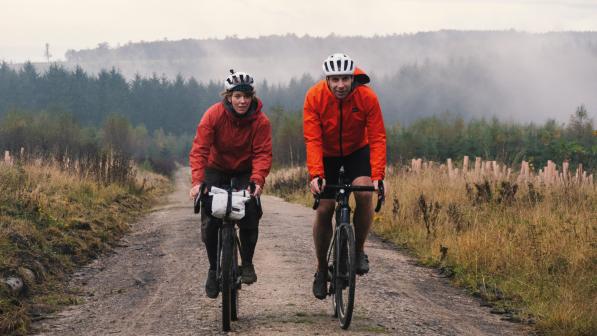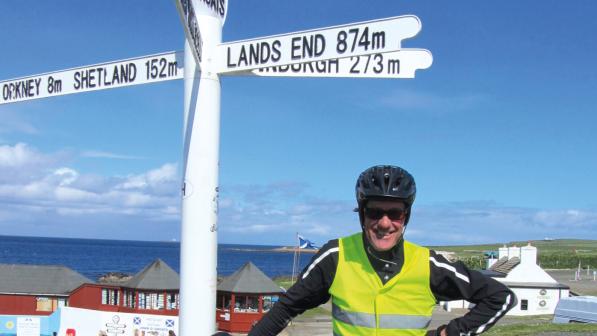Great rides: Boring to Dull

The best adventures have a way of finding you, even if you weren’t looking for them. I think big cycle trips need a purpose, with a definite start and end. I also like them to be somehow unique or unusual. In 2022 I became the first person to cycle through all of the 204 Ordnance Survey Landranger maps in numerical order. This unlikely journey began in May in Shetland and ended in Cornwall, more than 7,000 miles and six months later. Little did I know that this first cycling adventure would lead to my second one.
I was in Scotland for many glorious weeks. Towards the end of a sunny day on map 52, just after Loch Tay, I encountered a large road sign saying ‘Welcome to Dull, paired with Boring, Oregon, USA’. I took a photo for my blog, finished my day and went out for a well-earned curry, thinking little more about it.
In January 2023 I flew to South America, with nothing planned for when I returned in late March. I don’t like that feeling: it is always better to have something to look forward to. Then a friend invited me to hike the Pacific Crest Trail for the whole of July, south to north across the mountains and wilderness of Washington state to the Canadian border. I jumped at it.
Then I learned we would be starting near Portland, Oregon. A memory flickered in the recesses of my mind. Oregon is a big place but our trail started just a few miles from Boring!

A boring send-off
I decided that after the hike I would cycle home. Or at least across America. One spring day, the concept of Boring to Dull arrived and wouldn’t go away. Internet research revealed that the state of Oregon passed a law in 2013 designating 9 August as ‘Boring and Dull Day’, which is celebrated in Boring every year. I knew what I had to do. I had a week to prepare after my month of hiking, then I could be there in person to start my next cycling adventure.
Of course, I needed a bike. The obvious choice was the same Sonder Colibri that took me through all 204 OS maps in 2022. After a comprehensive service, it was FedExed to a friend’s house in Seattle, where it was waiting for me after my hike, along with my trusty old Carradice panniers. I was ready to ride.
Boring, Oregon is 20 miles east of Portland, which is 80 miles from the Pacific Ocean. Although my Boring-to-Dull quest took me ever eastwards, I wasn’t going to miss out on an American coast-to-coast. So I caught a bus west to a stunning place called Oceanside, where I dipped my feet in the sea. I rode to Boring from there, arriving late in the evening of 8 August.
The Boring and Dull Day celebrations were bigger than I expected. I was hosted by four local dignitaries over lunch and then invited to follow the bagpipers at the head of ‘Oregon’s second-shortest parade’. My presence caused a ripple of interest and I was introduced to – and photographed with – many people. In the early evening my new friends waved me off on my adventure.

Below the 49th parallel
My plan was simple. I would ride in a straight line from Boring to the east coast, about 2,500 miles as the crow flies and perhaps 3,200 miles by road. That took me past some friends who live in Minneapolis, about halfway, where I would get my bike serviced. I was allowing six weeks for this journey, cycling an average of 90 miles each day, six days a week.
I didn’t know what exact route I would take or where I would stay, except for the first couple of days along the vast Columbia River Gorge. This was an obvious and truly scenic way to begin. I stuck mostly to the north side of the gorge, following the broad, blue expanse of water, surrounded by hills and waterfalls. I rode under the watchful presence of the glacier-capped Mount Hood, which loomed large over the southern horizon as much as 50 miles away, close to Boring. As a springboard to the American West, it was ideal.
I was relying heavily on Google Maps, because America is simply too big to map on paper with the detail of an OS map. Overall, Google Maps did well. But as early as my second day, I learned that many of America’s back roads are rough, unsurfaced gravel, and Google Maps likes to send unwitting cyclists along them. I had a couple of dicey and unwelcome episodes in the first week but survived to tell the tale. At the time I thought I was in the middle of nowhere. I revised my opinion about that in week two. It’s a question of scale. And space. Empty space. Lots and lots of it.
Following advice from local cyclists, I stuck to US Route 12 across arid eastern Washington state. I stayed with it through Idaho, over the Rockies and right across the hills and vast plains of Montana and the Dakotas to Minnesota. That is almost half of the USA. Although it felt counter-intuitive, following this main road was a life saver in these vast open spaces. Perhaps literally.
Within a few days, the daytime temperature had risen to over 100 degrees Fahrenheit. The occasional small towns and gas stations offered essential refreshment and hydration opportunities, not to mention air conditioning! I wasn’t used to this but I found it less punishing than I feared. While you are moving, you create your own breeze. Only when you stop does it truly feel like you are in an oven.
Upper Midwest and Canada
My choice of route made it difficult to get lost. There were many, many miles of long, straight, empty highway, occasionally punctuated by a place of substance like Lewiston, Idaho on the Snake River, or the pleasant small Montana cities of Missoula and Helena.
Until now I was mostly passing through attractive countryside, following big rivers through forested hills and crossing mountain passes. After Helena things changed. For 10 days, I passed through endless miles of farming country, with grain silos, ranches and not much else for company.
The biggest empty space was 80 miles to reach Baker, Montana. But it was often a few hours of hard cycling to the next run-down town, which seldom amounted to much when I arrived. I stayed in motels, which were all similar and perfectly comfortable but short on character. Aside from a couple of people’s homes, the only accommodation that stood out was a bizarre add-on to a speedboat showroom, clearly designed for hunters, complete with fridges and instructions for what to do with your kill! Luckily I was alone.
The Twin Cities of Minneapolis and St Paul and their urban sprawl came as a major cultural and physical change. I had reached the Mississippi River and symbolically moved from West to East. I followed the equally hot, but more populated, scenic and historic Mississippi River valley for three consecutive nights, and then shot east across the abundant state of Wisconsin. I really liked its capital city of Madison, surrounded by large lakes, and also enjoyed myself in Milwaukee on the shores of Lake Michigan. The big news here was that their ‘Bronze Fonz’ statue, celebrating the famous TV character from Happy Days, had been sprayed black overnight. As a token visiting foreigner I made the local news, although my bike got no mention.
I took a ferry across the lake to Michigan and another much smaller one from there to Ontario, Canada, where I hugged the north shore of Lake Erie for a couple of very pleasant days. The Great Lakes are well named – they feel like the ocean but for the lack of salt in the air. I was passing through unassuming small places I had never heard of. Then suddenly, above the flat landscape, rose a cluster of ugly, high-rise buildings. I had reached Niagara Falls.

North Atlantic drifting
There is no denying the spectacular nature of the falls themselves. They are truly a wonder, best enjoyed from the Canadian side of the border. Impressive for their sheer size and force, and illuminated in ever-changing colours by night, this would be a highlight of any trip. Yet the human development nearby is really tacky. Think Blackpool on steroids.
After a rest day I was ready for the final USA section, the Empire State Trail. It took me and my friend Simon (who joined me for a week) right across New York State to the bottom of Manhattan Island. It was very pleasant, attractive and mostly traffic-free riding along the Erie Canal and then the mighty Hudson River. The final morning was especially memorable as we cycled towards the skyscrapers of New York City, finishing within sight of the Statue of Liberty.
Except it wasn’t the end for me. One overnight flight later I was in chilly Reykjavík, Iceland, where I needed completely different cycling clothes. My plan was to cycle right across the north of the country, via the Arctic Circle, to the eastern tip. I hadn’t reckoned on the Icelandic wind. Even in September it was brutal. There is no shelter here from the elements, and only one road to follow, which takes all types of traffic. It is a different world in every sense.
I was fine until the second afternoon, when I reached a mountain pass. That is when my golden rule was broken. It stopped being enjoyable. Honestly, I have never experienced wind like it on a bike. I was scared. I was also leaning at 45 degrees just to stay on. After another morning of the same thing, I bailed and headed for the Republic of Ireland. It was an easy decision.
Heading north into Northern Ireland, I made the last passenger ferry of the year from Ballycastle to Port Ellen on Islay, off Scotland’s south-west coast, where a straight line drawn from New York to Dull makes landfall. I had to dodge some cataclysmic Atlantic storms but managed to enjoy four glorious days of cycling through Scotland, arriving in tiny Dull for lunch on 12 October, exactly 10 years after the first celebration of its pairing with Boring. The only man left in Dull from those earlier days was there to meet me, 4,546 miles from Boring. I had joined these tedious twins in one of the most interesting journeys of my life.
Cycle magazine
Every two months Cycling UK members receive Cycle magazine, filled with interesting and informative articles, news and reviews for all cyclists.
Members can read the magazine in full online; non-members can read selected highlights.


